Table of Contents
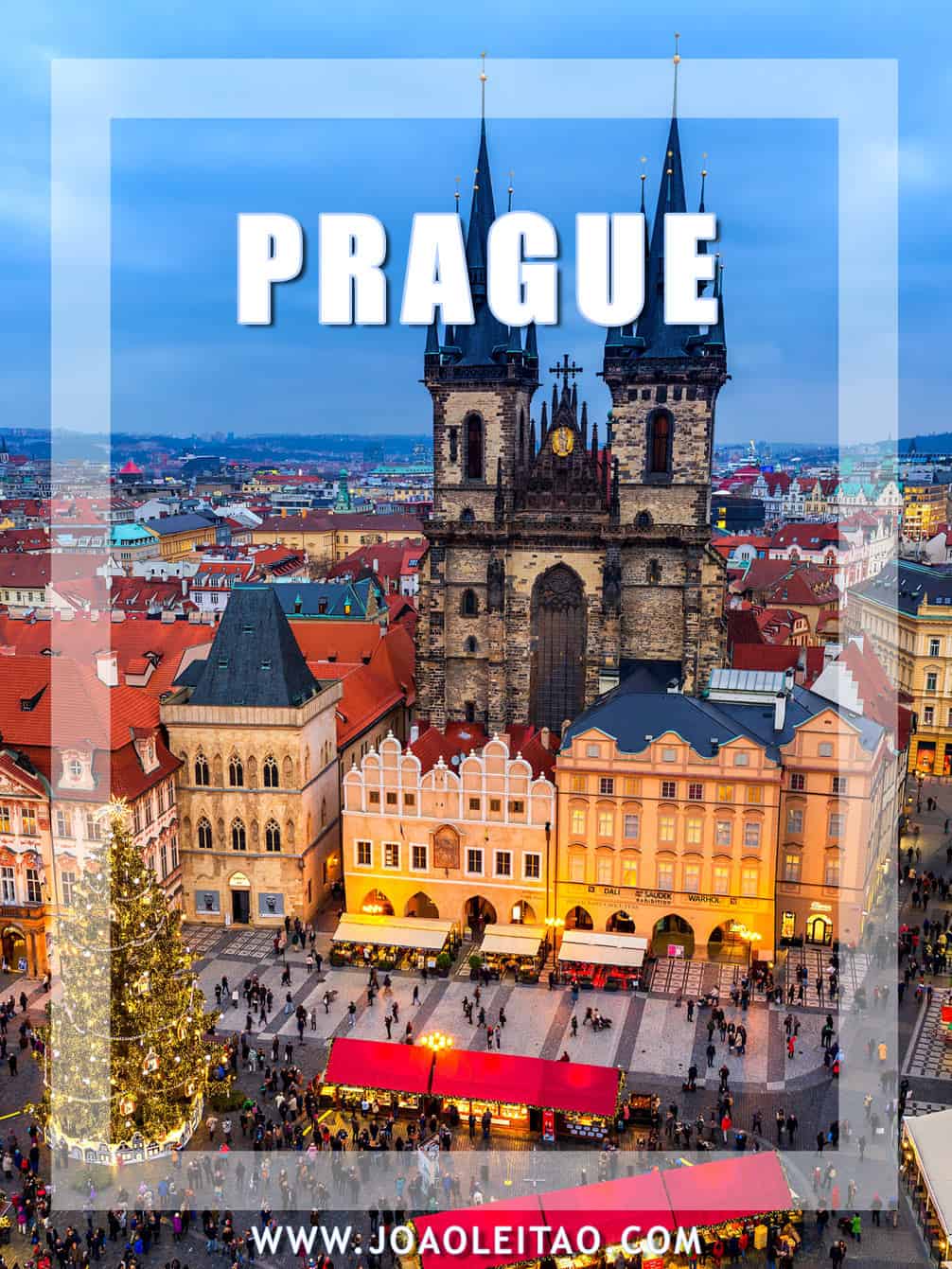
Prague is one of the most visited cities in the world and, no doubt, for excellent reasons. In 2016, nearly six million people visited Prague and the city became the 20th most sought-out by tourists.
The architectural heritage of its historic center is invaluable and the Vltava River adds a romantic touch to the city.
Perched upon hills, on the shores of Vltava River, Prague is the capital city of the Czech Republic. It’s unbelievable how much architectural and cultural heritage this city has.
It’s known as the “City of One Hundred Spires” and is full of beautiful bridges. Prague was an essential stop on the commercial routes that connected the North and the South of Europe. Traces show that the Celtics settled here in the 3rd and 4th centuries BC.
Prague has so much to see you must plan your trip well, to make sure you get the most of each site and have a memorable holiday.
Prague Top 5
1
Charles Bridge
2
Prague Castle
3
St. Vitus Cathedral
4
Orloj Astronomical Clock
5
Old Town Square
Visit Prague – What You Need to Know
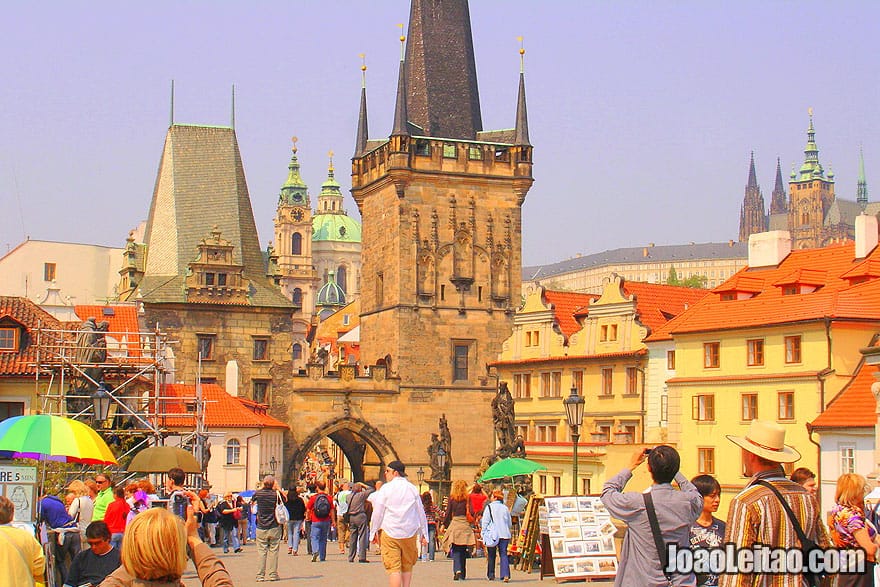
Wake up early and be the first at monuments, museums, or other landmarks.
The Czech Republic hasn’t adopted the Euro yet and its local currency is the Czech Koruna (known as Korunní in Czech), shortened as CZK. Therefore, it’s necessary to get Koruna for your days in Prague.
You can withdraw cash in the local currency with your credit or debit card at an ATM (called Bankomat in Czech) or exchange money at a dedicated business.
There are thousands of small currency exchange businesses, especially in the tourist areas, but you need to be careful because some charge high service fees or have lousy conversion rates. You can trust the eXchange at 14/13 Kaprova street, near the Old Square.
What’s Prague 1, Prague 2, Prague 3…?
Prague’s division into numbered areas or districts is similar to the administrative division we know as Parishes.
Some are simple too, for example, Prague 1 is the Old Town and Prague 2 is the New Town.
After that, it gets complicated. On the one hand, generally speaking, the higher the number, the farther you are from the city center.
On the other hand, the beautiful neighborhood of Letna, across the river and from the Old Town, is Prague 7 and the distant Nusle is Prague 4.
Here’s a tip: try to ignore these numbered districts and, when necessary, focus on the name of the neighborhood.
Best Time to Visit Prague
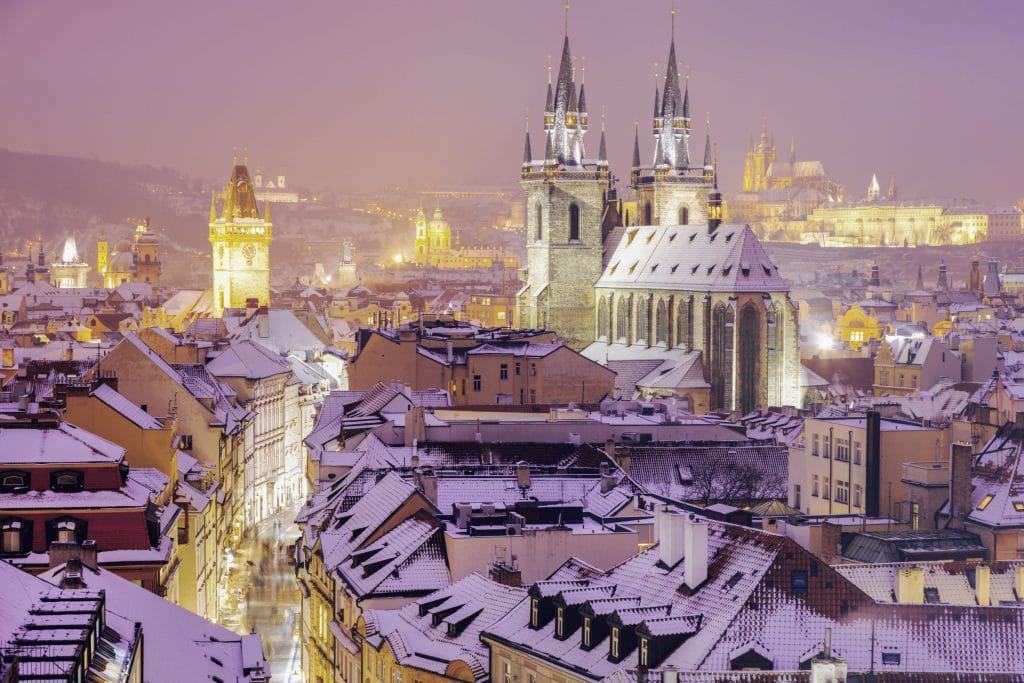
I’ve visited Prague three or four times and always at different times of the year. I experienced completely different temperatures and weather. In the summer, it was sunny and warm, and in the winter, it was snowing and cold, with temperatures of 17 degrees Celsius below zero.
October and November – Fall’s Warm Colors
October is an excellent choice. The crowds of summer tourists are gone and the weather is mild with almost as many activities and events as the previous months. It’s true that you feel the city is getting ready for the winter, though. The city is not as lively and is preparing for the first snowfall. The leaves change at the parks of Prague and they are covered in fall’s golden colors. It’s still amazing to see, though!
November to March – Cold and Maybe Some Snow
Between mid-November and March, it gets cold. Not as cold as it used to be, truth be told. You don’t have to be very old to speak of past winters when snow was high and the river froze, thus becoming a natural ice-skating rink. But times are changing. Yes, it’s still cold and exceptionally the temperature might drop to 20 degrees Celsius below zero, but it’s generally around zero degrees Celsius.
Keep in mind that continental cold is different, more bearable, and that our bodies experience these zero degrees the same way we would experience 10 degrees Celsius in a more humid climate. This is the time of year when prices and number of tourists drop at the same time the temperature does. I visited Prague twice around this time of year and I enjoyed seeing the city covered in snow despite the cold.
Many people fantasize about a trip to Prague covered in snow. It reminds us of Christmas cards. Unfortunately, over the last few years, it’s snowed less and for shorter periods. It’s impossible to pinpoint the perfect time to see snow. A blizzard could come early in November, or you could get to winter without spotting a single snowflake. It’s all about luck.
April to June – Spring Arrives
After the dark and gloomy winter months, people in Prague get ready for spring. And the city transforms itself at the first signs of the new season. The parks are full of people and there’s a rare sense of happiness in the air. Everyone goes out and no one goes home straight from work. First, there’s stopping for a beer and for hanging out with friends.
Even so, April can be gray, rainy, and cold. The trees remain bare until late. Parks began to turn the color of the first leaves on the last week of the month. In May, everything is in full bloom and it’s a great time to visit Prague, before the tourist invasion in the summer and with fine weather. June is when you begin to feel summer is coming and with it the street markets, cultural events, and outdoor concerts. For many, that is the best time to travel to Prague.
July to September – Lively and Rainy Summer
Before anything else let me clarify that it rains here in the summer. And it rains a lot. August is the third month of the year with the highest rainfall. July, the fourth month. But the temperature is steady and pleasant and there’s a special vibe in the air. People are more relaxed and the city’s rhythm slows down. But as the city’s locals go on their vacation, tourists crowd the most interesting neighborhoods. It’s hard to find suitable accommodation and the number of tourists is suffocating.
On the other hand, it’s a good time of year to explore Prague off the beaten path: in the more remote parks, there’s also something happening, events, gatherings. A time to be amazed. I visited Prague around this time of year and I enjoyed seeing the city, bright and with good weather.
Top things to do in Prague
- Charles Bridge
- Prague Castle
- St. Vitus Cathedral
- Orloj – Prague Astronomical Clock
- Karlstejn Castle
- Old Town Square
- Petrín Tower
- Wenceslas Square
- St. Martin Rotunda
- Dancing House
- Church of Our Lady before Týn
- Lennon Wall
- Strahov Monastery
- Municipal House
- Petrín Park
- Clementinum (Klementinum)
- Old Jewish Cemetery
- National Museum
- National Theater
- Josefov Neighborhood
- Powder Tower
- Prague Jewish Museum
Map of attractions in Prague
Map with the most popular attractions in Prague
Best places to visit in Prague
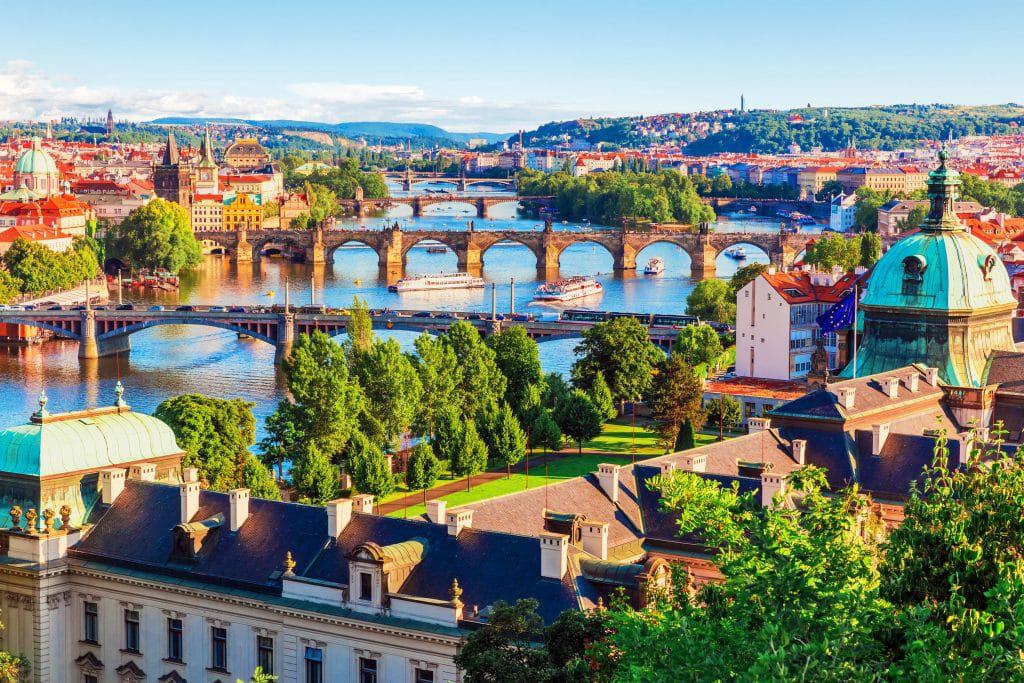
For tourists, Prague is usually these five neighborhoods:
- New Town (Nové Město),
- Old Town (Staré Město),
- Jewish Neighborhood (Jisefov),
- Lesser Town (Malá Strana),
- and Castle (Hradcany).
I’ll introduce each one of these neighborhoods, so you’ll understand how the city is organized for tourists and so you can easily put together an itinerary of Prague.
See also the other section where I write about the monuments in the Czech capital, with practical information and the History of each one of the best places to visit in Prague.
But first, let’s talk about the neighborhoods.
1. New Town
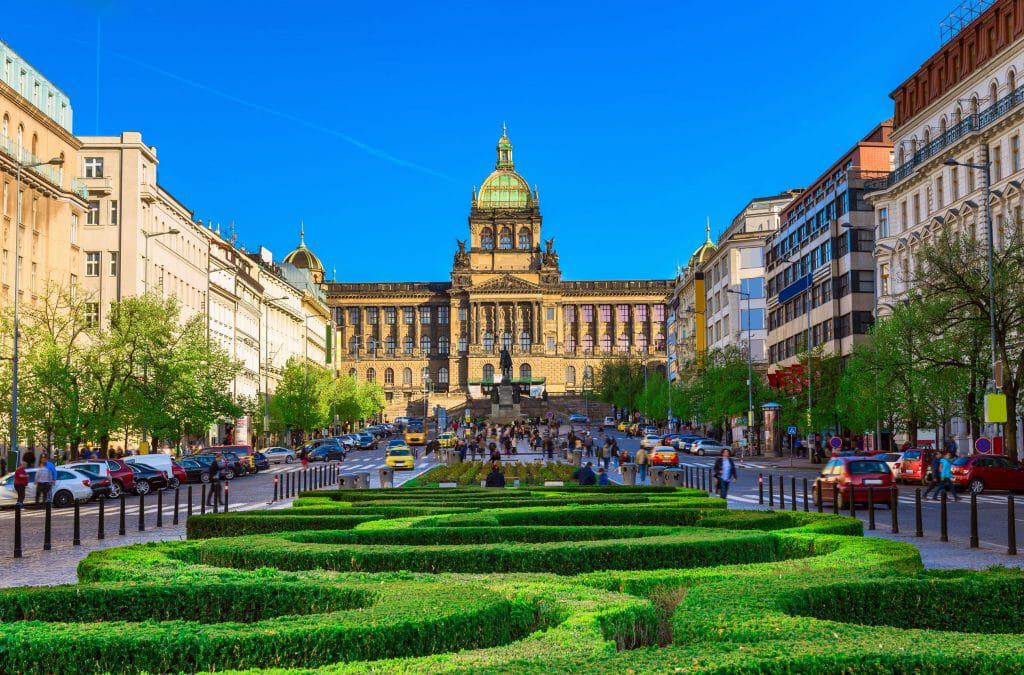
Prague’s New Town encircles the Old, keeping it isolated by the river and separating it from the newer neighborhoods of Vinohrady and Zizkov.
Despite the name, there is nothing new about this part of the city. The name comes as a comparison with the Old Town, even older than this one, but it was founded in 1383 by King Charles IV.
Nowadays it’s a nice balance between modern and historical elements, with the monumental Wenceslas Square in the center, topped by the National Museum and the legendary equestrian statue where, according to local tradition, young lovebirds arrange their dates behind the horse.
This square was full of people in crucial moments of the country’s History. This is the site where Czechoslovakia became independent after the First World War and where the Germans paraded after the annexation of 1938. On its cobblestones, the people of Prague tried to resist the Soviet domination and young student Jan Palach burned himself to death in protest, right on the spot where you can see the discreet monument in honor of his sacrifice. Finally, it was there the Czechs started the Velvet Revolution that brought back democracy.
Today, it’s a lively site, a hub of local shops, always busy with people. It’s served by two subway stations where the three subway lines overlap and from here you can easily reach the river, the new neighborhoods of Zizkov and Vinohrady by going down Narodni Avenue, and the old heart of the city by entering the narrow medieval streets.
Not too far from here, within five minutes walking distance, you’ll reach the Karlovo Square with its beautiful park where, in the Middle Ages, a cattle market took place.
The Narodni Avenue that serves as a border has a rich History and it’s the place where you’ll see the two most important historical cafes in Prague: Slavia, on the corner facing the river, and Louvre, further up the street, on a second floor. Across the street from the Slavia, the National Theater, a majestic building made by public subscription, which means with donations from anonymous citizens. That was at a time when, although it was part of the Austro-Hungarian Empire, Bohemia was strongly nationalist and felt the need to bring theater in Czech to the masses, considering all cultural events were performed in German.
If you follow that avenue across the river, you’ll be walking on the Legií Bridge. Halfway, you’ll see some stairs that will take you to Shooters’ Island. This site has been recently remodeled and now has strict rules (for example, you can’t consume alcohol). It’s a pleasant area but, most importantly, from the tip of the island, you’ll get the best photos of the Charles Bridge, beautifully framed by the historical buildings of Prague.
At the back of the theater you’ll find an interesting part of the city, secluded, full of interesting cafes and restaurants, where a tourist can get lost safely, walking until reaching Myslikova Street (wider and clearly the end of this micro-neighborhood) or, going up, Spálena and the Narodni Trida subway station.
Walking from the National Theater alongside the Vltava River, you’ll notice the charming building facades and the island in the middle of the river, which is easy to reach if you decide to spend some time exploring it.
You won’t help to notice a peculiar building on one corner, called the Dancing House. There’s a café-restaurant at the top and, if you’re interested in knowing more, this building was made in this modern style in the middle of classical buildings to fill a hole that was left after a bombing during the Second World War.
Fun fact: the first president of modern Czechoslovakia, Vaclav Havel, grew up next door and was personally involved in the making of the Dancing House.
If you walk by here in the evening, you’ll notice a crowd of people gathering by the river, weather permitting. In recent years, it’s become customary to come here to Naplavka to have a drink and meet with friends after work. The bars on boats docked in the pier are particularly nice, and one of them is actually a floating theater. If you’re looking for a more upscale atmosphere or a perfect place for a romantic dinner, try the Matylda Restaurant right at the beginning of Naplavka.
You’ll eventually reach Palackého Square, from where I suggest you walk one block inside. Tourists usually don’t come this far and the buildings, mostly from the early-20th century, are beautiful. Then go to Svobodova and the railroad. On the corner, next to the river, there’s a fabulous ice cream shop you must absolutely visit. Vysehrad is across the street, outside the limits of the New Town.
2. Old Town
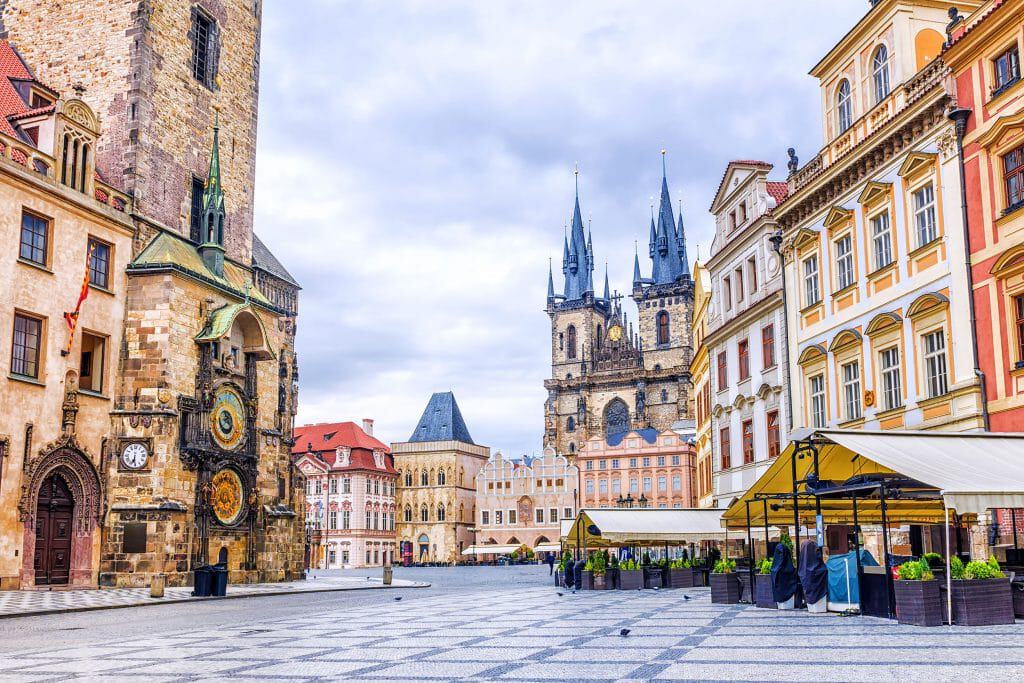
The Old Town Square (Staromestské námestí) is the heart of the Old Town, from where all roads depart and to where all alleys lead when you’re walking around Prague.
It’s impossible to describe all the architectural heritage you’ll find here or even attempt to suggest an itinerary. The streets are too narrow and the magic is too high. The only way to explore this part of the city is to let yourself go, wandering, getting lost on cobblestone streets, paying attention to every little detail as they unfold.
When walking here, it’s crucial that you look up because the buildings’ décor can be incredibly beautiful high above. And there are other surprises too, like that mysterious sculpture hanging from a suspended beam between rooftops.
Insider’s tip: if you’re brave enough to go out at sunrise, you’ll have a different perspective of this classical and always crowded Prague. Of course, you won’t be the only one with the same idea, but it will be a different experience.
3. Josefov
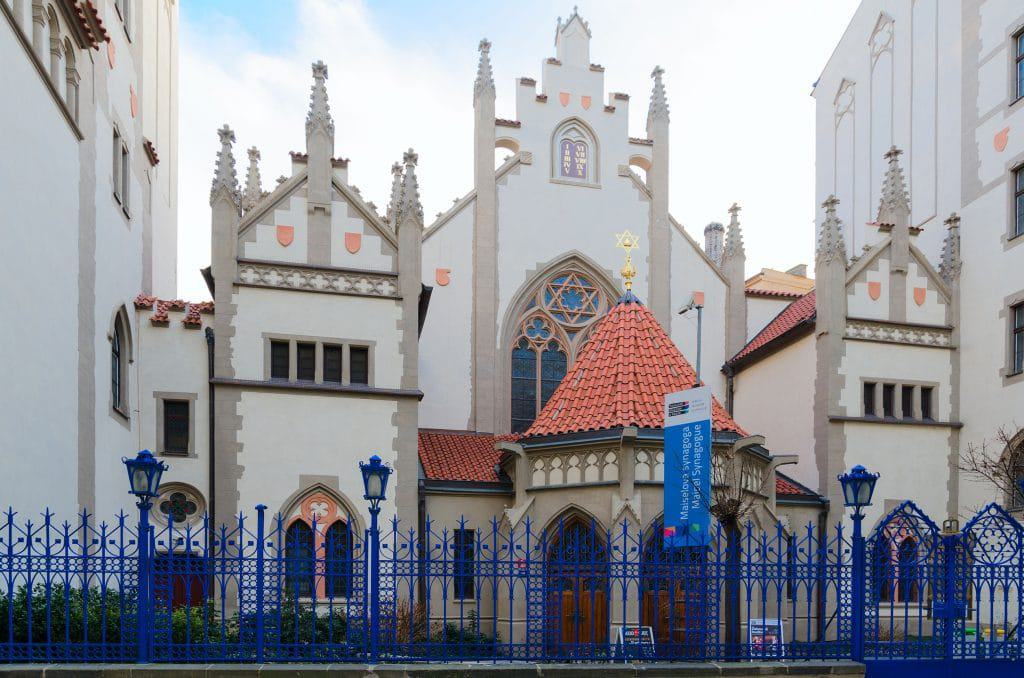
For many people, the Jewish neighborhood is part of the Old Town but let’s address it as a separate block. The name Josefov was given by the neighborhood’s residents as a token of appreciation for King Joseph II’s Edict of Tolerance in 1781.
Nowadays, you’ll still see traces of Hebrew presence in this neighborhood and it’s common to see men wearing the yarmulke, that cap many Jewish men wear. But the neighborhood went through profound changes between 1893 and 1913 when the local authorities decided to redesign the city like Paris. Six synagogues (the oldest dates back to the 13th century), the cemetery, and the old neighborhood headquarters were the only pieces of Jewish heritage that survived. That sense of Jewish neighborhood you still feel in the streets of Bairro Alto or Alfama in Lisbon is lost. The streets of Josefov blend in with the streets of the Old Town, and it’s interesting to wander around here.
The Prague Jewish Museum houses all Hebrew heritage and has a central ticket office where you can buy combined tickets to visit all the Jewish sites including the old cemetery.
But there are other sites here that deserve a closer look. The birthplace of the famous Jewish Czech writer Franz Kafka, at Franze Kafky street, is one of them.
The admission ticket costs 40 CZK. If you’re interested in the life and work of this author, who by the way wrote in German, you’ll want to have coffee at the Slavia where the writer spent a lot of his time.
What is probably the smallest house in Prague is another one of the interesting sites you can see here, at 1043/4 Anežská Street. It’s really tiny! It’s 1.5 meters wide, was initially built three centuries ago and restored in 1853 to house an art workshop. At the beginning of the 20th century, it was the home of a local prostitute.
4. Mala Strana
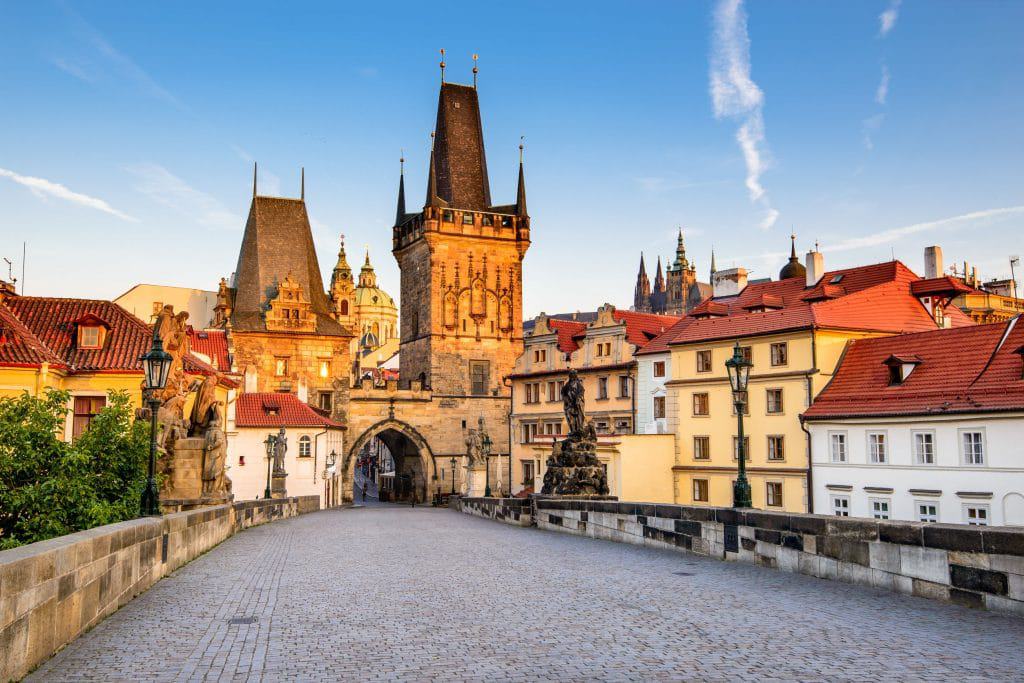
This is the classical part of Prague across the river, between Charles Bridge and the Castle, stretching alongside the bank of the Vltava River.
To reach here, you have to cross Charles Bridge, the oldest of the many bridges over the Vltava River. Its construction began in 1357 on the same site where there used to be another bridge, destroyed by a violent flood. It was finished about 50 years later and named Stone Bridge or, sometimes, Prague Bridge.
The current name was given in 1870. It’s a 240-meter long bridge, supported by 16 arches laid on stone ice-breakers. The bridge is decorated with 30 Baroque-style statues, most of them religious, placed on the bridge in 1700. Please note that the ones you see now are replicas from the original statues that were either damaged over time or are safely stored at the National Museum.
Mala Strana includes the beautiful Kampa Island where you can see the John Lennon wall in front of the French Embassy at Velkoprevorske Square. That was the site chosen by a group of young people to pay tribute to the British singer when he was murdered in 1980. At the time, you could be punished just by listening to western music, which means those Lennon fans were remarkably brave. For years, the wall was a symbol of the opposition against the dictatorship and a site of constant civil disobedience. Local authorities would paint the wall white and guard the premises, but rebel and daring youngsters would come back to write the same poems and “subversive” words on the wall.
On this island, there is also a large lawn where Prague locals flock to on sunny days turning this into a social gathering spot.
The narrowest street of Prague is in Mala Strana, an alley so narrow that only one person can walk through it at a time. Although it’s officially a street, it’s actually the remains of a fire escape pathway that people used to quickly reach the river to fetch water to put out the fire. To see it, look for U Lužického Semináre street. Coming from Charles Bridge, walk by the Shakespeare bookstore (a great place to buy English books on Prague), and you’ll see the narrow pathway a few meters ahead, on the right side.
You walk by Mala Strana on your way to the Prague Castle and there are different ways to get there. The best way is probably to go up Nerudova street, named after Jan Neruda, a Czech writer who lived here and who included the street and the neighborhood in many of his stories. The more famous Pablo Neruda adopted the name of his Czech predecessor.
Pay close attention to the symbols over the doors of several of the beautiful houses that flank the street. More than a décor, these symbols were practical. Before houses had postal numbers, the symbols allowed mail carriers to identify the recipients of the letters they had to deliver.
For example, notice the façade of number 47, where Jan Neruda lived, and you’ll see a beautiful symbol depicting two suns. In the present time, if we were to send a letter here, we would send it two 47 Nerudova – Praha 1. But at the time the author lived, we would address it to Jan Neruda — House of Two Suns, Nerudova, Praha.
There are other buildings with interesting symbols on Nerudova street. Number 12 has Three Violins because three families who built hose music instruments lived there. Local folklore says that when the moon is full, you can hear mysterious violin tunes here. Number 32 has a Golden Lion and now houses a small museum dedicated to the classical pharmacies of Prague. Number 41 has a Red Lion and was the house of painter Petr Brandl, whose art pieces decorate some of the churches in the city. On number 44, the house where Neruda lived after his father died is called Three Black Eagles.
This system started in the mid-14th century and by that time there were about 230 houses identified using that system. By the 18th century, there were 900 houses. Today, only 200 houses have such symbols, and although it’s true most of them are at Nerudova Street, you can see them all over traditional Prague.
Although technically not part of the neighborhood, the Petrin Hill, that you see from Prague’s central riverside area, is a natural extension of Mala Strana. It’s a beautiful urban park that stretches uphill. There are several routes you can take to explore this calm side of Prague. Mid-hill, there’s a restaurant with great views that you can reach by taking the elevator that connects Petrin to Mala Strana.
From Petrin, you can walk the park pathways to the Castle or go in the opposite direction to Kinsky Park, which is a natural extension of the hill. There are several paths to Petrin; one of the main ones is through the park where you can visit the Ethnographic Museum.
Several pleasant surprises hide in the middle of the forest, like the Hunger Wall built by the king in a year of bad harvests and famine. According to legend, building the wall fed the people who were paid in cereal by the king himself for their labor. St. Michael’s church is another hidden gem, a wooden Orthodox church that was brought from Ukraine to Prague for the 1891 Universal Exhibition.
In the border of Mala Strana, in Ujezd, on the foothills of Petrin, you’ll see the impressive Memorial to the Victims of Communism. It depicts the destructive effects the regime had in the country through a series of human figures on steps, in different stages of decay, one more decomposed than the last. The work designed by sculptor Olbram Zoubek and architects Jan Kerel and Zdenek Hoelzel was inaugurated in 2002. The following year, one of the statues was blown up by a bomb and, recently, another one was partially damaged by an unknown citizen.
5. Hradcany
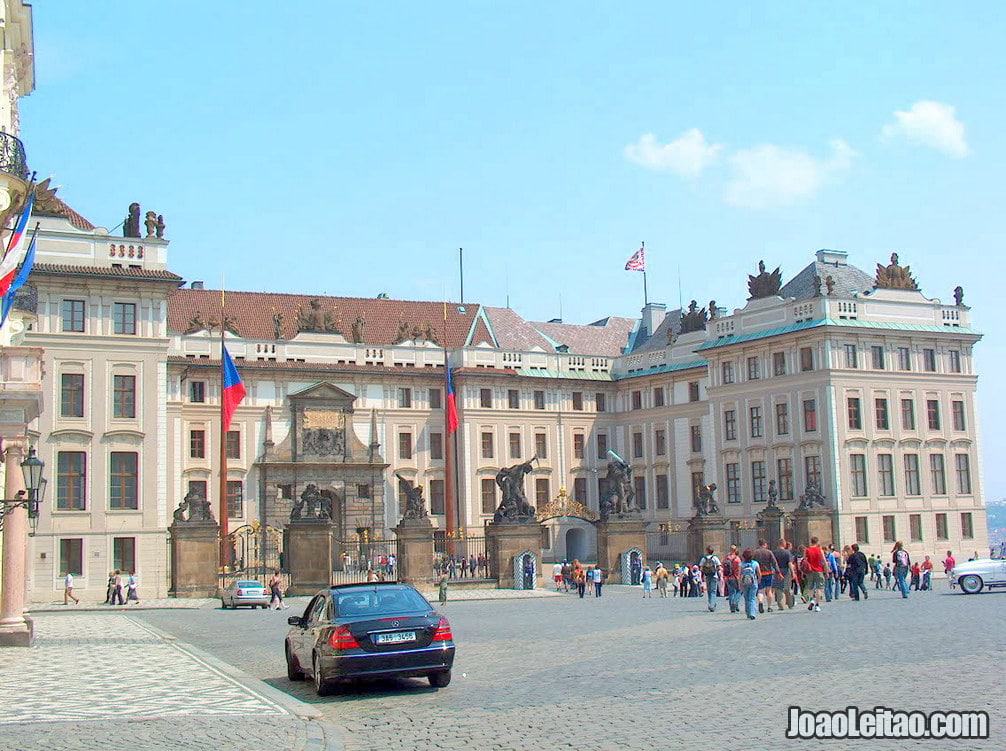
Prague Castle is the main site in Hradcany. Although calling it a “castle” might be dubious, considering we’re in the presence of the biggest castle in the world according to the Guinness Book of World Records, which records the total area at 70,000 square meters.
Nowadays, the Castle tries to combine two distinct purposes. On the one hand, it’s the seat of the Czech Presidency of the Republic and houses several other government departments. On the other hand, it’s one of the most visited sites in the city with about two million tourists every year.
The caste’s public areas are open from 6:00 am to 10:00 pm, although occasionally visitors might be forbidden to go inside because of official State visits or ceremonies.
As for the museums, they’re open from 9:00 am to 5:00 pm. Make sure you check the official schedule ahead because there are exceptions and timings change often.
You can buy different types of combined tickets. The most expensive tickets cost 350 CZK and include everything, whereas the cheapest tickets cost 70 CZK and allow you to access only the Power Tower. Check the full price list here. Please note that to visit the castle or the gardens you won’t need a ticket.
Inside the castle, there are many points of interest and the gardens, if opened to the public at the time you visit, are worth it. The main attraction is probably the St. Vitus Cathedral, a massive temple built over hundreds of years where in 925 there used to be a small chapel. The cathedral began construction in 1344 and, surprisingly, it went on until 1929, perhaps making it the construction work to go on for the longest period in the History of humankind.
Other sites you’ll see inside include the Romanesque-style St. George’s Basilica and several museums and historical areas open to the public including the former Royal Palace, the exhibition showcasing the castle’s History, the Powder Tower, the cathedral’s treasury, and the art gallery.
The Golden Lane is an apparently normal street inside the castle, where common citizens lived until the Second World War. The houses here are historical, but you have to buy an admission ticket to visit. However, you might be able to visit for free in the evening and, at that time, it will also be less crowded.
Although it doesn’t have a tradition as old as the ceremonies at Windsor Palace, the change of the guards here is still a spectacular event to attend.
But there’s more to Hradcany than just the castle and there are other points of interest, mainly behind the government complex. The Baroque-style Loreta Church, for example, is a beautiful church with a carillon that chimes every hour. You can visit inside the church (150 CZK) and it’s worth it.
Nearby, just around the corner, you’ll see the photogenic Phorolec Square that deserves a closer look. Under the arches, there are several cafes and the whole atmosphere of the square is how most tourists imagine Prague to be like. From there, you can go back to the Nerudova street through the quieter Úvoz or, if you prefer, walk the pathways in Petrin Hill. Alternatively, you can visit Strahov Monastery and go to the fabulous library (80 CZK) that looks straight out of a Harry Potter book.
6. Vysehrad
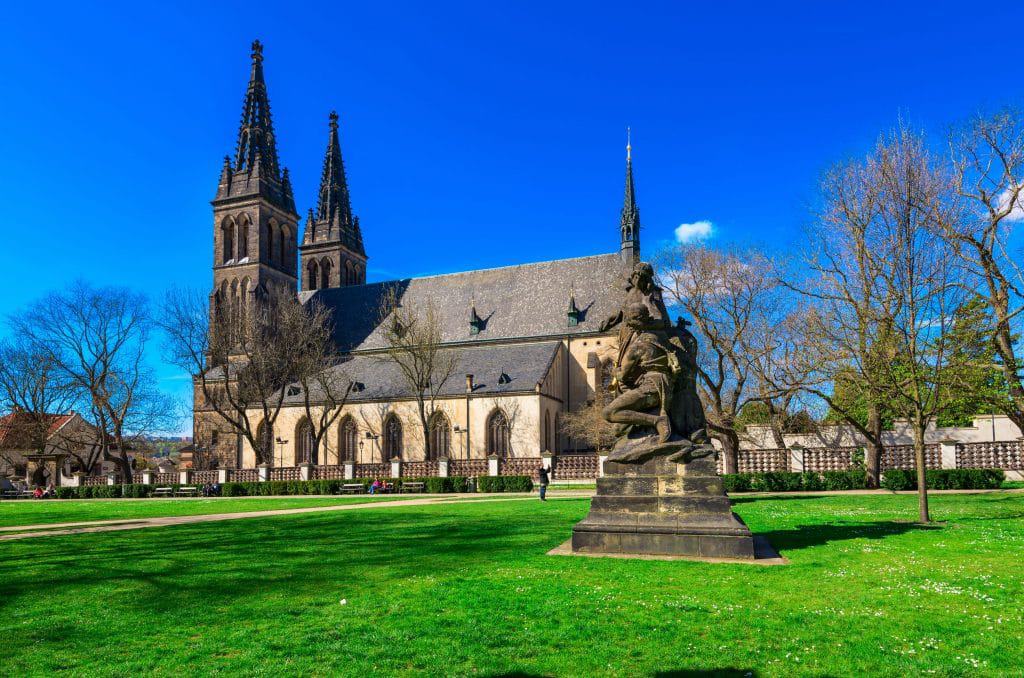
Vysehrad Fortress, perched upon the hill over the Vltava River, is a relatively modern version of the castle that used to be there and that was, in fact, the city’s historic center where it all began.
According to legend, Princess Libuše of the Lech tribe lived here around the 7th century, and ruled the kingdom based on her visions. On one of those moments, while staring into infinity, she suddenly said “I see a city such glorious that it will touch the stars” while pointing to where the Castle is now. She then instructed her trusted staff to go search for the man who was building the arch of a door. Wherever they found him, they would start the construction of a new city that would be called Praha (práh in Czech means “door arch”).
Although many centuries have passed since power shifted from Vysehrad to the Castle, the Czechs have a strong emotional attachment to the place where it all began. This is where you can visit a cemetery that doubles as a sort of national pantheon, near the Basilica of St. Peter and St. Paul. Prominent figures of local History are buried there such as Josef and Karel Capek and composers Antonin Dvorák and Bedrich Smetana to name just a few.
The current fortress is the result of several alterations and improvements done over the centuries, but it’s mostly a good example of the Austro-Hungarian military architecture of the mid-19th century. It’s a great place to explore, complex and full of nooks, but still compact. Inside you can visit the St. Martin Rotunda, a small Romanesque chapel built in the 11th century and perhaps the oldest building in the city. There aren’t many more traces of medieval Vysehrad apart from the Špicka gate (from where you enter if you’re coming from the station) and the ruins of an old watchtower now known as Libuše’s Bath.
You have a great view of the river from the Vysehrad walls, with the Castle in the background and a big part of the historic center. The river flows on the opposite side, unveiling places where tourists hardly ever visit like some islands on the Vltava, the Podoli neighborhood, and, on the other side, Barrandov.
There’s a “beer garden” inside the fortress which is a great spot to have a pint of beer and snack on some typical grilled food. The atmosphere is not touristy at all, nor are the prices.
You can reach Vysehrad on foot from the city center, walking by the river until you reach a railway bridge. It’s a nice walk to do slowly, but if you prefer you can take the red subway line and get off at Vysehrad station.
7. Letna
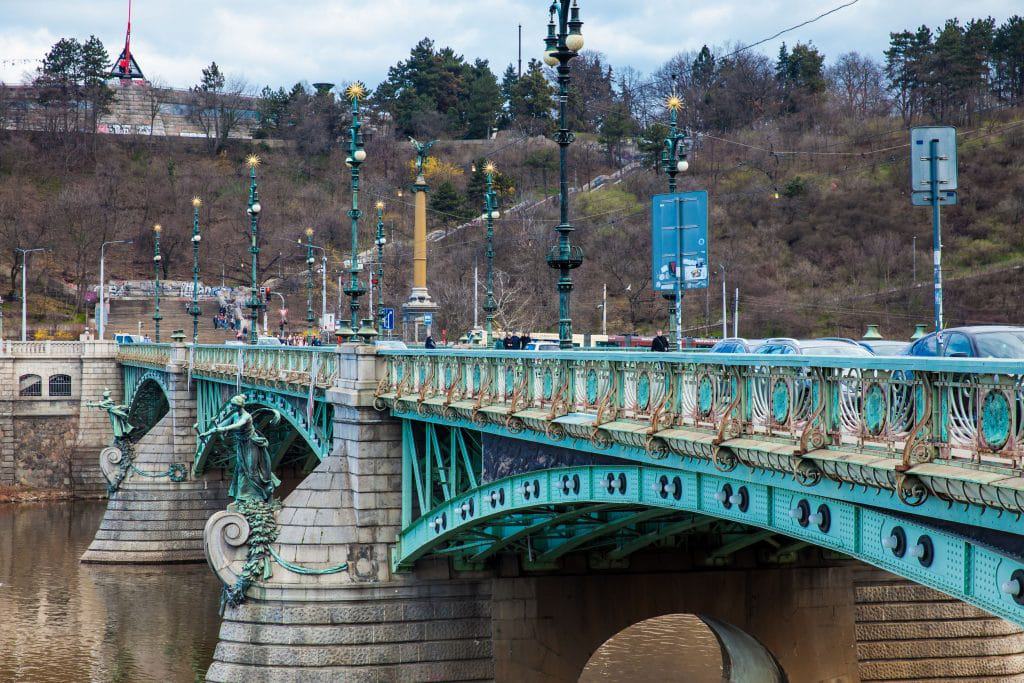
One of the coolest neighborhoods in Prague, known for the good quality of life, central but still keeping a small neighborhood vibe with quiet streets and easy access to two beautiful urban parks.
It’s on the opposite riverbank and you can reach Letna by tram (1, 2, 8, 25, 26) or by walking from the Old Town via the Revolucní Avenue, crossing the bridge, and going up the ramps and stairs that lead to the top of the hill on the other side. The neighborhood, slightly hidden, is right behind.
To reach the neighborhood, you have to walk across part of the Letna park where you’ll find one of the most famous “beer gardens” in the city, where you can have a beer with an amazing view of the Prague’s old neighborhoods. If you walk a little to the left, through the garden trails, you’ll see the Metronome (the perpetual pendulum) on a terrace from where you can take the best panoramic photos of the historic center, the river, and the bridges. At the prime time of Stalinism, after the Second World War, the Communist regime built a statue to the Soviet leader here, which was taken down after his death.
Letna is a neighborhood with a grid layout, full of cafes, restaurants, and pubs. It’s also where you’ll find one of the best museums in the city, the National Technical Museum that combines with the National Museum of Agriculture.
Walk across the neighborhood to see one of the largest parks in Prague, Stromovka. It began as royal hunting ground created in the 13th century and became a park in the 16th century with a lake that’s still there today, populated by friendly ducks. It became a public park in 1804 and not much has changed since then. It’s been a favorite spot for Prague locals to spend some quality time for over 200 years.
8. Vinohrady
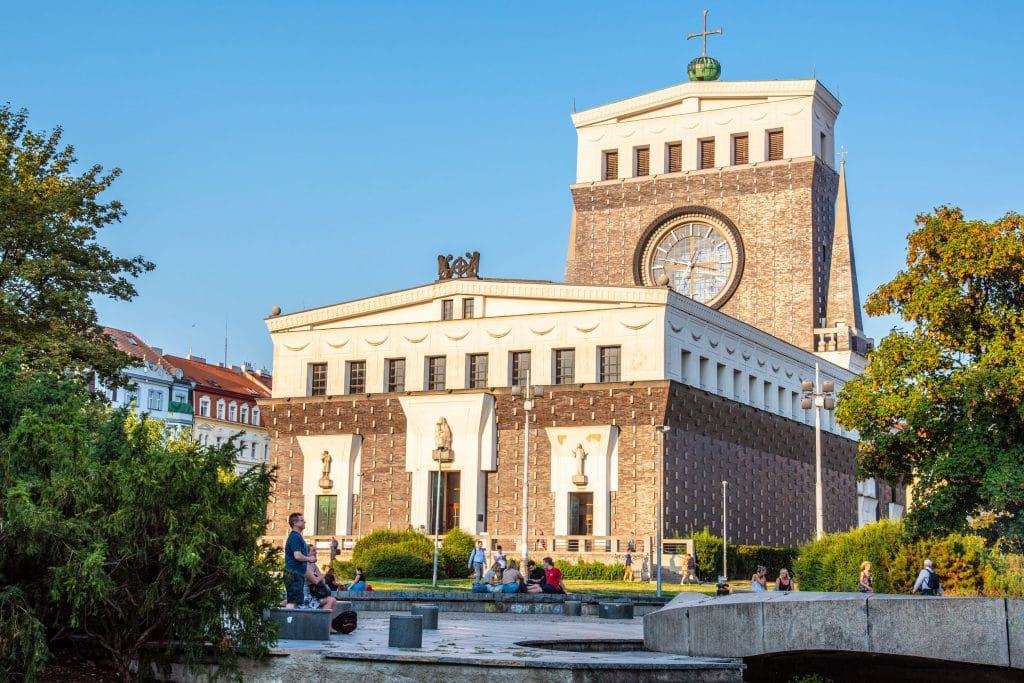
The name of this neighborhood means “vineyards,” and you can still see some vineyards from the Havlíckovy sady park on the far end of Vinohrady.
It’s a cosmopolitan area liked by Prague’s expat community and by an intellectual high middle class that comes here for long afternoons of debate in the many cafes and breweries in the neighborhood.
If you enjoy walking, you can get here from the river walking alongside the tram trails and going up the Resslova street that begins near the Dancing House. You must then cross Karlovo Square and, if you want to, you can visit the site of an important battle that took place during the Second World War, at the crypt of the church St. Cyril and St. Methodius that you’ll see on your left side.
You’ll walk past IP Pavlova, a well-known public transportation hub with a red line subway station and many tram routes, and then reach Namesti Miru square. There’s an excellent Christmas Market here that’s a good alternative to the very touristy one that takes place at the Old Square. Other events take place frequently in front of the Church of St. Ludmila, the towers of which you can see from almost all high points in the city.
If you prefer to take public transportation to visit the neighborhood, get off at the green line subway station of Namesti Miru or catch trams 22, 10, or 16.
Although it looks like you’re a long way from the historic center, all the buildings in Vinohrady date from the late-19th century or early 20th century, designed in Art Nouveau, Pseudo-Baroque, Neo-Renaissance, and Neo-Gothic styles.
From the Namesti Miru square, you can take one of the streets to your right where you’ll find great cafes and restaurants. These streets, like many others in the neighborhood, are residential streets, quiet, and lined by leafy trees that fill the street with cooling shade in the spring and the summer.
Going back to the square, you can go up Korunny Avenue until you see a beautiful tower on your right side that, despite the architectural grandeur, is just a water tower. It’s a Neo-Renaissance design by Antonín Turka and was built in 1891. It worked until 1962 as part of the city’s water supply network.
Nearby, in a park on the right side, you’ll see a church with a peculiar design. It looks more modern than it is. It was built in the 1930s and during the Second World War, it was the setting for fights between the German occupants and the Czech resistant.
You can go down Nitranska Street from the water tower, where you’ll also find good places to eat or drink something, and you’ll reach Jiriho z Podehbrad, a square with a complicated name but an interesting vibe. Markets selling fruit and vegetables or with food stalls take place here frequently. All of this across another church with a unique design, Nejsvetejsího Srdce Páne, designed in the 1930s by the same architect that played an important role in redesigning the Prague Castle.
9. Zizkov
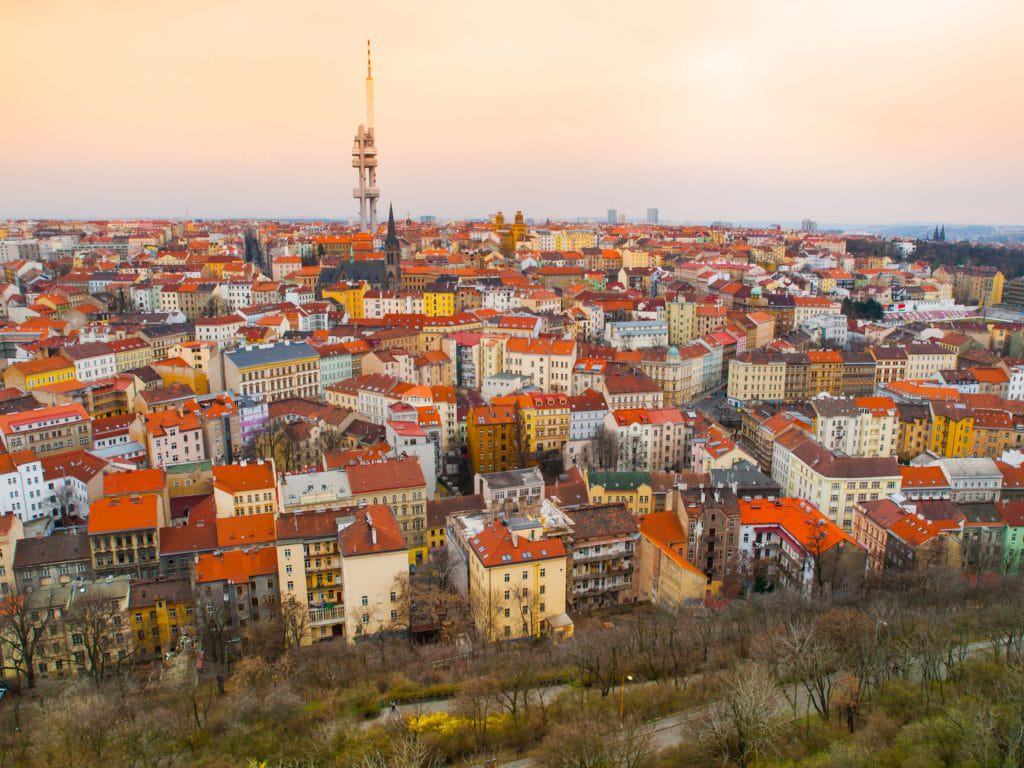
Vinohrady and Zizkov are the real-life embodiment or rich family versus poor family. The first one, always bourgeois and cosmopolitan, while the second one kept its industrial and socialist atmosphere for decades.
Dividing these two neighborhoods, the Vinohradská street, which we crossed earlier when we reached Jiriho z Podehbrad.
On that square, look for Laubova Street (if you’re facing the church door, it’s the street on the left) and walk down that street until you reach a quiet roundabout. There you’ll see the U Sadu, a nice, typical pub serving beer produced by small local breweries, with different brands every week. It’s also a good place to grab a bite where the kitchen is unusually open until 2:00 am.
A friendly tip: if you’re going with a group, take note of all you order and double check everything when it’s time for the check.
But let’s continue our walk. Let’s turn right on this roundabout and reach the Žižkov television tower, a landmark in the city that caused a fuss when it was built in the Communist period. People didn’t like it and nicknamed it the “penis of Prague.” They even spread the rumor that the Government had technology that allowed them to spy on the citizens of Prague from the tower. You can visit the tower and access the observation deck from 9:00 am to noon. The regular admission ticket costs 230 CZK.
Now you can walk down Onderková until you reach Táboritská, and turn right. A little further ahead, on your left side, you’ll see the entrance to Parukárka Park. You can visit if you wish to spend some time on a place where locals go to lay on the grass with a beer they just bought from the “beer garden” near the entrance. However, it’s only worth going when the weather is nice in the spring and summer.
Instead of focusing on your left side now, walk a bit further to Jicínská and look for the secondary gate to enter the Olšany cemetery across the street. It has a laidback vibe and a picturesque atmosphere, and the artistic quality of some of the tombstones make it one of the must-see sites in Prague. It was built in 1680 to bury the victims of the plague.
One hundred years later, the King forbade bodies to be buried within the city limits, and this cemetery grew. Near the gate through which you’ll enter the cemetery, you’ll see the older tombs, but the whole cemetery is historically relevant. Prominent historical figures buried there include young Jan Palach or the great Communist leader of the second half of the 20th century Klement Gottwald. In another section, which you’ll reach after walking for almost 1 km across this cemetery and crossing a street, you’ll find the Jewish cemetery where Franz Kafka is buried.
Eating & Drinking in Prague
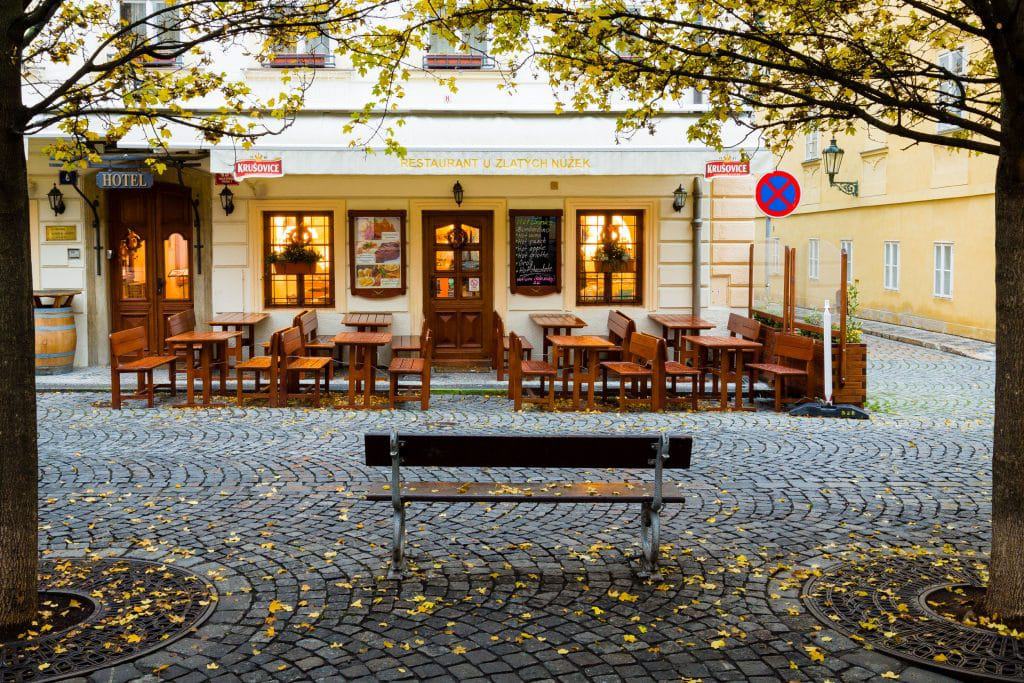
The Czech local cuisine is the typical Central European: heavy, designed to give you lots of energy for hard labor in the fields during the cold days of winter. Heavy in meat, thick gravy, and potatoes.
Pork dishes are the most common in restaurants. As for fish, river fish like trout is what you’ll find the most on the menu. There’s a good range of vegetarian restaurants with high-quality menus.
Czech cuisine might seem bland to a tourist, who will form their opinion based on what they’ll eat at restaurants of course. But here’s the catch. Most of the really typical dishes take hours to cook and require a degree of commitment you could only expect from a full-time housewife. Maybe that’s why they tend to vanish in time. They still survive but not for tourists.
Restaurants don’t really care about keeping traditional cuisine alive, considering how difficult it would be to manage, and unless you have a connection with a local family, you’ll have a hard time trying the delicacies of the bohemian cuisine.
That being said, let’s move on to what is available and delicious. On cold days, I suggest garlic soup. It sounds strange, but it has amazing, invigorating power. It’s a watery broth heavy in garlic and with pieces of smoked meat, served with slices of fried bread that you soak in the broth to thicken it.
Goulash is another must-have dish, different from the well-known Hungarian version. In Hungary, goulash is a sort of soup while in the Czech Republic it’s a regular meat dish. If you find a place that serves boar goulash, don’t skip it. If not, go to Ferdinanda at Wenceslas Square. They serve a goulash made with tender beef with a generous portion of their secret recipe gravy. All paired with slices of compact and moist bread, which they call dumplings, used to soak up all the gravy. The price is also a pleasant surprise. You won’t pay more than 150 CZK, and that includes a small glass of beer. The goulash is their specialty, which means you won’t wait much time to be served.
Barbecues are very popular, especially in outdoor festivals and beer gardens. You have lots of varieties to choose from, but I suggest the klobása, different types of sausages, grilled and served on one or two slices of dark bread. There are some barges by the river shores that do it very well, preferably washed down with a glass of heavenly cold beer.
Speaking of beer, that’s something you’ll always find in any pub. Even when they tell you there is nothing to eat if you insist and ask directly they might admit they do have something to eat like Nakládaný Hermelín. This is a Camembert-type of cheese marinated with pickles and served with bread. It’s a typical snack to pair with beer.
Each establishment has its own way of preparing and serving this cheese. It’s an art and there are even official competitions. One of the best is at U Sadu.
Please note that in local restaurants you must order the side dishes separately, which sounds strange to me as Portuguese, but it’s actually quite convenient. Considering the variety of side dishes available, you can custom-make your dish.
Those with a sweet tooth should lower their expectations. There are no desserts in Czech cuisine. Over time, menus began to include two options: ice cream and crepes.
If you’re a foodie, embrace a trip to Prague like an opportunity to try more exotic cuisines. World cuisine is well represented in the Czech capital, with more exotic options like Afghanistan, Sri Lanka, Georgia, or Ethiopia. But you’ll also find the ever-present Chinese, Indian, and Italian restaurants. You’ll also find plenty of vegetarian and vegan options.
As for drinks, beer is king. After all, Czechs are the people who drink the most beer on average per person. Beer culture is ever-present. At the supermarket, you’ll find dozens of brands and it’s cheaper than bottled water. There are beer bars that change brands every week, with draft beer from small producers.
Zlý Casy is one of those places. It’s in 5 Cestmirova and you reach by taking tram 18 and getting off at Námestí Bratrí Synku stop. Beer is the main drink and they serve many different varieties, some more strange than others. They have a natural flavored beer with cherry or ginger, semi-filtered beer, dark beer, and semi-dark beer. Prices vary. Some of them are rare or limited editions and they’re obviously more expensive.
Wine is not the drink of choice here, except at dinners with friends or on a special occasion. But if you want something local for after your meal, try the plum slivovice. This fruit brandy is also made with pear or grape.
Nightlife in Prague
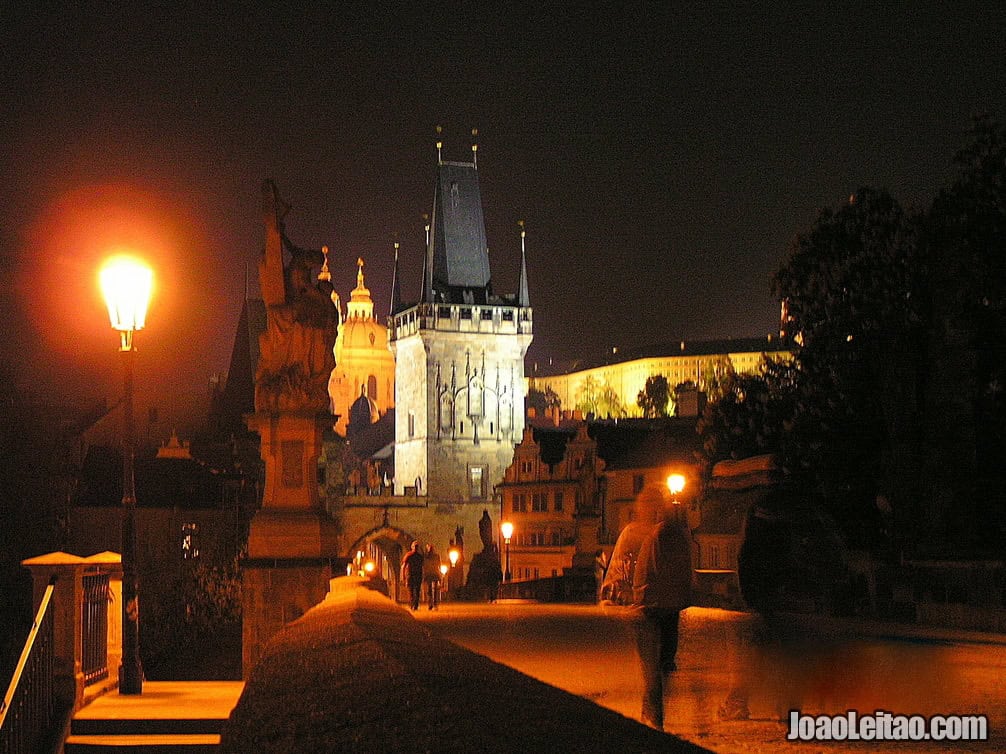
Most of Prague’s nightlife happens on Dlouha street, very close to the Old Square, where Roxy is the most famous hangout. But there are other great spots all over the city. In Prague, party time is every day of the week, not only on Friday and Saturday night.
Just to give you some suggestions: at Narodni avenue, under the arches, in front of the Louvre café, Vagon has live music every day with a dance floor open till dawn. And if you come after the concert, you’ll probably won’t have to pay to get in. The drinks cost about the same as any other pub in town.
In Zizkov, near the TV Tower, the Akropolis is a complex with a restaurant (avoid it at all cost), concert halls, and dance floors. Party is on all week and on Sunday, entrance is free for Reggae night.
In the center, by the river, between Charles Bridge and the National Theater, the Kalrovy Lazne caters to a younger generation, popular among city-breakers who come to Prague for the weekend, especially the British.
Cross Club, near the Holesovice subway station, has a unique vibe. The club, bar, and dance floor are decorated with sculptures made with metal scraps. It’s like a living art installation where pieces are changed and added all the time.
An efficient network of trams and night buses make going out at night quite easy. You’ll hardly ever need to grab a taxi to go back home.
Where to Stay in Prague
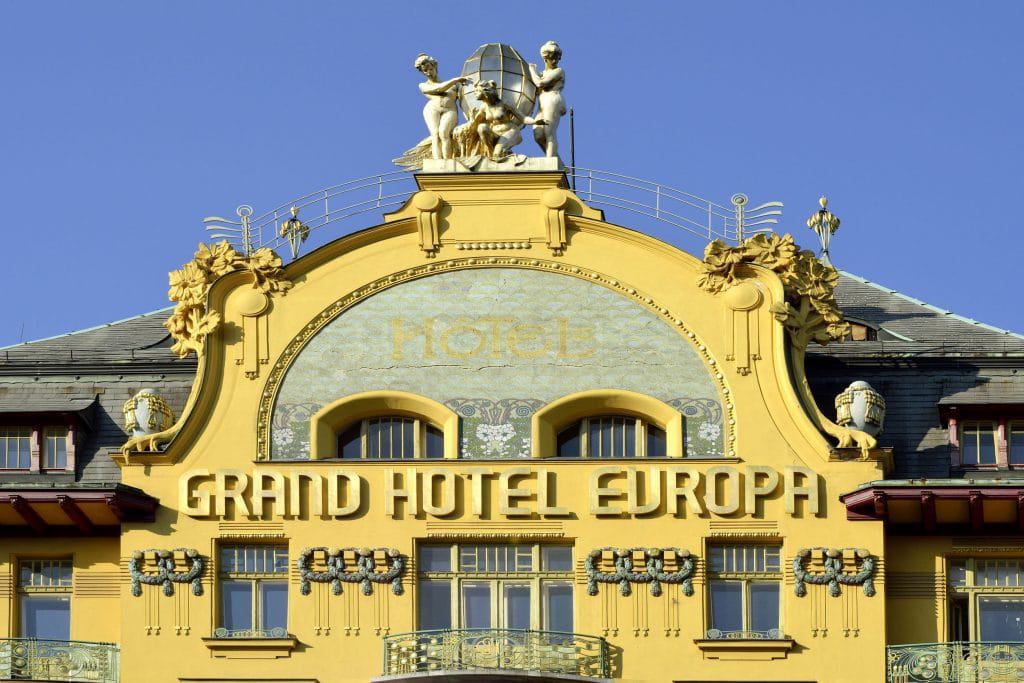
When it comes to accommodation, each person has different needs and expectations. In Prague, anything is possible, from luxury hotels to private apartments, from Airbnb to budget hotels, and of course hostels. There are literally thousands of options, so I’ll just address the areas where you can stay in Prague.
Accommodation options concentrate mostly around Wenceslas Square, the center of modern Prague, an iconic location where the most important events of recent History happened. Except that in recent years, it’s been the local haunt for less reputable people. After sundown, and sometimes during the day in an inconspicuous way, there is prostitution and drug dealing, and it’s the favorite place for groups of British on uncivilized bachelor and bachelorette parties and for all kinds of troublemakers. They’re harmless activities most of the times, but a nuisance nevertheless. The central train station is nearby, a place that also attracts dubious people. For all these reasons, I suggest you look for other areas to stay in Prague.
The historic center is appealing. It’s nice to be in the middle of it all, steps away from the main tourist attractions in the city, but it’s always busy and you can’t avoid the crowds of tourists visiting Prague. If you’re okay with is, then look for a central accommodation, a few hundred meters from Charles Bridge or the Old Square.
If you’d rather compromise and look for a place that’s a short walk from the main attractions but allows you to relax at the end of a busy day, find something in the maze of streets that go from the river bank to the Narodni Trida metro station, on the east side of Narodni avenue. The other side of the river is also a good choice, with lower prices and that touch of authenticity you can no longer find in the historic center.
How to get to Prague
If you’re looking for cheap flights, check the low-cost airline Ryanair. Keep in mind that not many low-cost airlines fly to Vaclav Havel airport, but considering the location of Prague, it won’t be difficult to come up with a mixed solution. For example, you can fly to Hamburg, Berlin, Budapest, and many other cities in Central Europe, and then take a cheap and fast train or bus connection.
Public Transportation in Prague
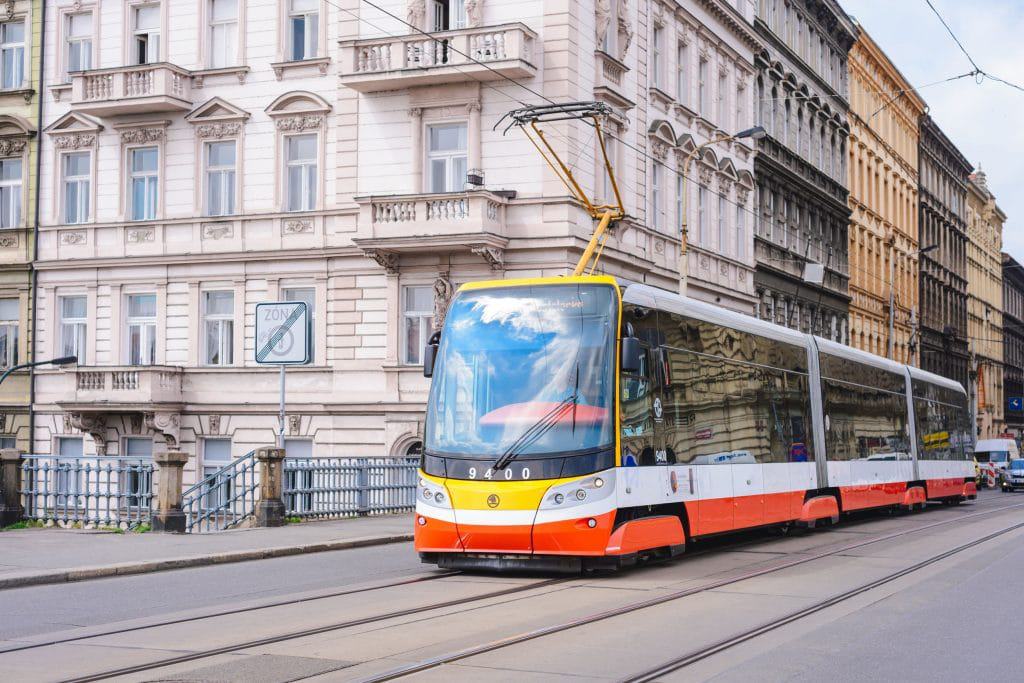
If you plan well, you’ll most likely won’t need to use the Prague public transportation often. The Czech capital is compact and most of the tourist attractions are within walking distance from one another.
There are special tickets for tourists that give free access to all the public transports in the city. A one-day ticket costs 110 CZK and a three-day costs 310 CZK. If you’re not planning on using public transportation so much, especially if it’s your first time in the city and all you want to do is explore the touristy areas, it’s best to buy regular tickets.
There are two kinds of regular tickets. For short trips up to 30 minutes, they cost 24 CK. For longer trips and valid for 90 minutes, they cost 32 CZK. Once validated, and within their time frame, these tickets work as a free pass for all means of transportation and for as many stops and stations you’ll use.
Please note that although there are ticket vending machines in all subway stations, you can only buy this kind of ticket in some (very few) tram and bus stops. You can’t buy this ticket from the driver. I suggest you buy a couple of them at the airport and keep them in your wallet until you need to use them.
From the Airport to the City
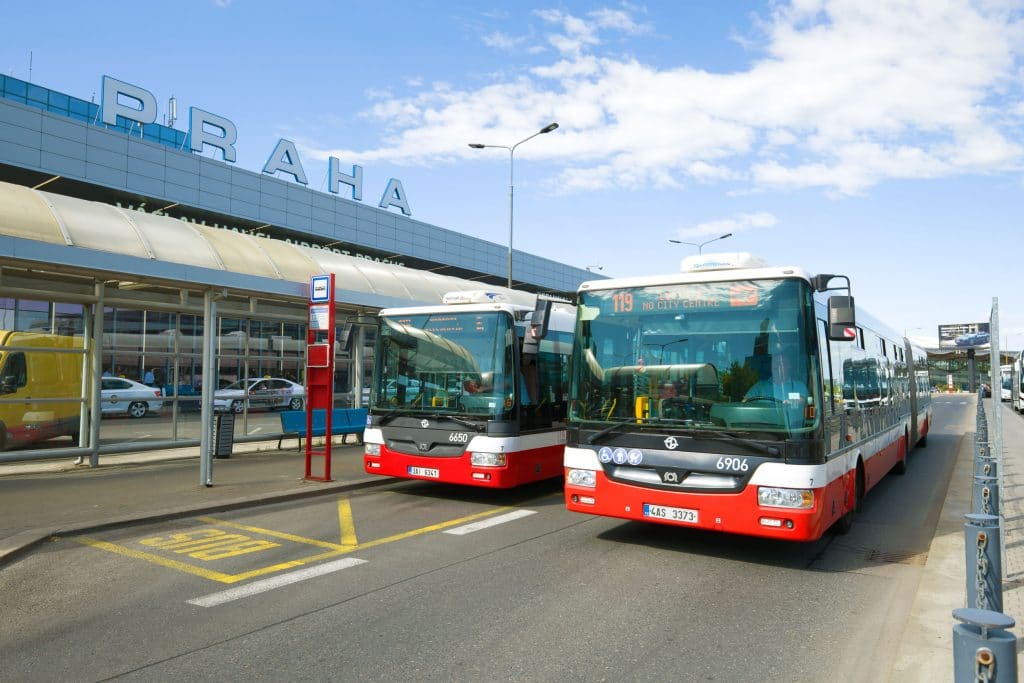
Unfortunately, the airport in Prague is not yet connected to the subway network. Even so, reaching the center is easy and you don’t need to spend extra money on a taxi, especially if you’re traveling light.
There’s a counter for Prague’s public transportation company at the airport where you can buy the ticket for bus 119 that stops in front of the terminal.
To validate the ticket when entering the bus, punch it in one of the machines near the doors. You don’t need to worry about which stop you get off, just travel all the way to the end of the route.
Bus 119 stops in Nádraží Veleslavín and the subway station is right in front of the bus stop. This is the green line, which serves the touristic areas and that will take you to the city center.
Because you’ve already validated your ticket, you don’t need to do it again to use the subway. Just get in. This is also a terminal station, so just follow where everyone else is going.
Map of Prague Subway
Here you’ll find a map of Prague subway. In the city, this is the best way to get around since Prague has a great subway system. Click on the map to enlarge and zoom.
Prague Itinerary: Coronation Route
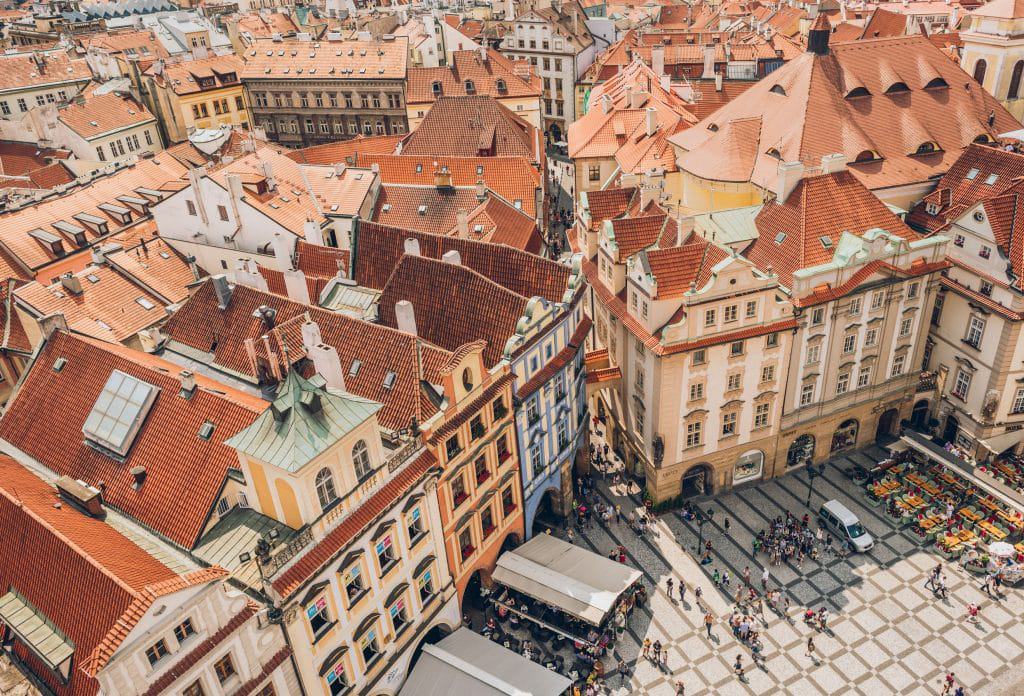
If you want to follow a fixed route, look for the Coronation Route followed by Bohemia’s monarchs on their coronation day. This route will take you across the river and to the castle, two areas I’ll be addressing in other sections of this article, so, for now, I’ll only explain the itinerary in Prague Old Town.
This tradition began in 1438 with Albert II of House Habsburg. In the following four centuries, consecutive sovereigns followed the same route until 1836, when Ferdinand I was crowned. The same course was used for the funerals of the kings who are buried in St. Vitus Cathedral at the Castle.
The route starts in Námrstí Republiky, in the New Town, easy to reach on foot and served by multiple trams and the yellow subway line. Before you begin the route, I suggest you take a look at the magnificent Art Nouveau façade of the Town Hall, decorated with beautiful mosaics and the symbol of the arts and culture in Prague.
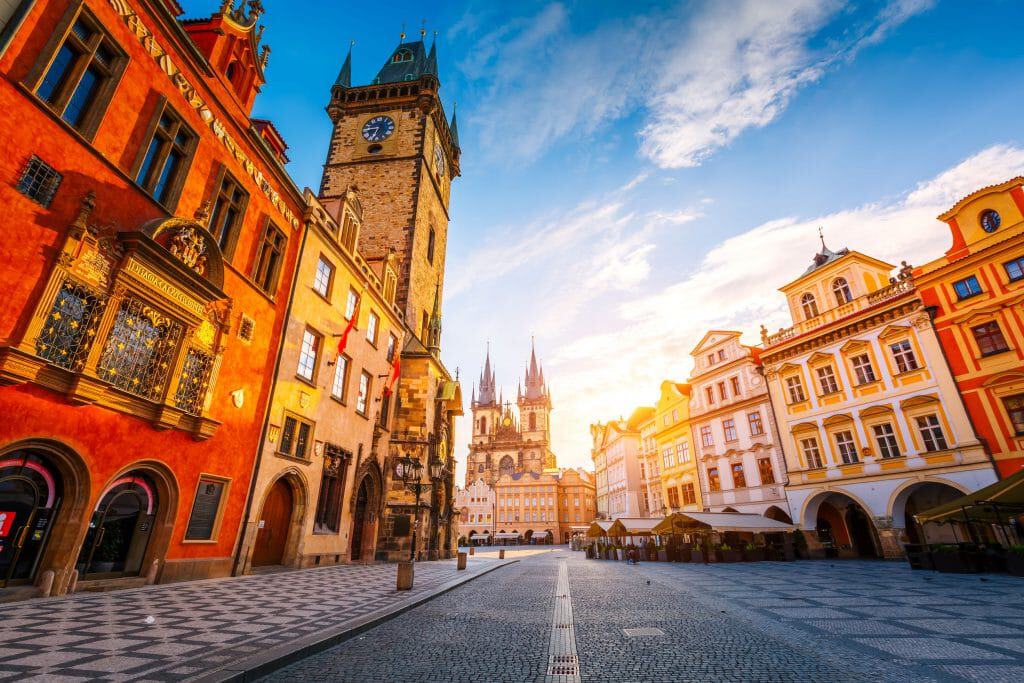
It’s a few tens of meters from here to the Powder Tower. Walk on the opposite direction of the square and you’ll see the tower on your right.
This impressive Gothic tower built in black stone is one of the 13 medieval gates of the city, built in 1475. It used to be called “New Gate,” and it only gained the current name when in the mid-17th century it was used as a gunpowder storage facility.
Walking under the arch of the tower, you’ll enter Celetná street, which leads straight into the Old Square. Notice the Cubist building at the corner with Ovocny street (yes, Prague is the only city in the world where Cubism influenced architecture). It’s the House of the Black Madonna that houses the Museum of Cubism and, on the second floor, the interesting Grand Café Orient.
You’ll reach the Old Square, where you must pay attention to the statue of Jan Hus, the old devout, blind, who raised an army of heretics against the Catholic forces of the Habsburgs. It didn’t end well for him. He gave the ruling dynasty some headaches, it’s true, but he ended up burning in the fire.
Still, on the same square, you’ll see the twin towers of the Gothic-style Cathedral of Tyn, the Stone Bell House, the Baroque-style church of St. Nicholas, and the building of the old Town Hall. The main attraction in the square is the Astronomical Clock that dates back to 1410, the oldest clock in the world still active.
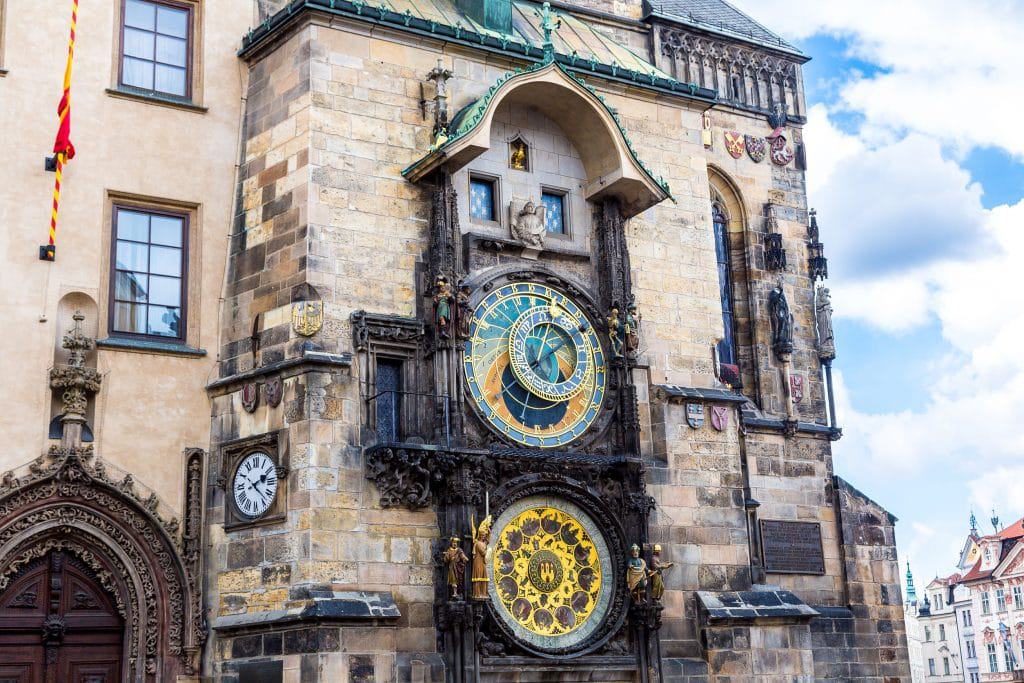
Every hour, the parade of the four figures inside the clock begins. They represent four negative traits, according to that time’s values: vanity, greed, luxury, and death. According to a legend, that locals take very seriously, when the clock stops because of neglect, terrible things will happen to Prague.
If you travel here in December, you can visit the Christmas Market. It used to be a classic Christmas event in Prague but has now lost some of its authenticity because of tourism. Prices are higher and customers are rarely locals.
When you’re done with feeling wowed by the square, look for the discreet exit through Karlova street, perhaps the most touristy area in the city, which after a few curves will lead you to the beginning of Charles Bridge and the end of the Old Town. At that moment, you can splurge a little and pay to go to the top of the bridge tower. The view is worth it.



